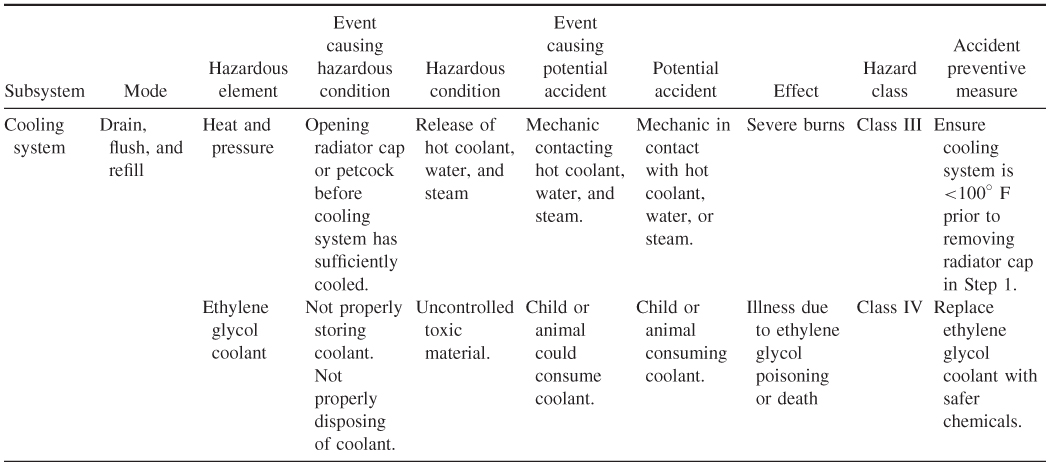6.2 Using Process Hazard for Procedure Design
PHA is most effectively used during the initial development of a process and the procedures for performing that process. Also, it has utility when updating/changing a process and its procedure. The following example illustrates its use for analyzing a maintenance process/procedure.
6.2.1 Purpose of Process
Flushing an automobile cooling system.
6.2.2 Initial Basic Procedure Steps
1. Begin with the engine cold and ignition off. Remove the radiator pressure cap.
2. Open the petcock at the bottom of the radiator and drain the coolant into a bucket.
3. Close the petcock and fill the radiator with water.
4. Start the engine and turn the heater control to hot. Add cooling system cleaner and idle the engine for 30 min (or as per the instructions on container).
5. Stop the engine and allow it to cool for 5 min. Drain the system.
6. Close the petcock, fill the radiator with water, and let the engine idle for 5 min.
7. Repeat step No. 5. Close the petcock.
8. Install new 50 : 50 mixture of water/ethylene glycol antifreeze/coolant.
6.2.3 Analysis
Table 6.4 shows the analysis of the procedure. Note that in a PHA the idea is to list the hazards and not to analyze each step in the procedure. Failure mode and effect analysis and failure mode, effect, and criticality analysis are better suited for analyzing the steps of the procedure.
Table 6.4 Analysis of Procedure
Note that there are two primary hazards associated with flushing the cooling system. They are the heat and pressure associated with the hot coolant and the toxic nature of the coolant itself. The accident preventive measures in respect to the procedure will result in the addition of two warnings and the substitution of ethylene glycol with a nontoxic coolant.
6.2.4 Using the Results of the Analysis
The procedure has now been revised based on the findings from the analysis. The new procedure reads as follows:
Warning: cooling system must be below 100 °F prior to draining.
1. Begin with the engine cold and ignition off. Remove the radiator pressure cap.
Warning: ethylene glycol coolant is toxic and must be disposed of in an appropriate manner.
2. Open the petcock at the bottom of the radiator and drain the coolant into a bucket.
3. Close the petcock and fill the radiator with water.
4. Start the engine and turn the heater control to hot. Add cooling system cleaner and idle the engine for 30 min (or as per the instructions on container).
Warning: cooling system must be below 100 °F prior to draining.
5. Stop the engine and allow it to cool for 5 min. Drain the system.
6. Close the petcock, fill the radiator with water and let the engine idle for 5 min.
7. Repeat step No. 5. Close the petcock.
8. Install new 50 : 50 mixture of water/nontoxic antifreeze/coolant.

